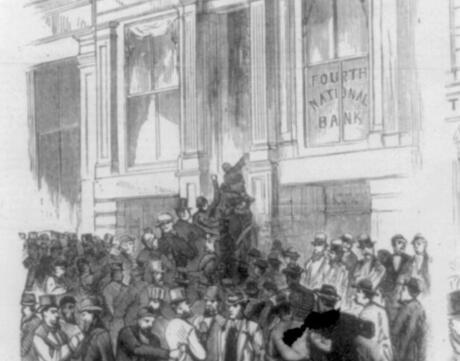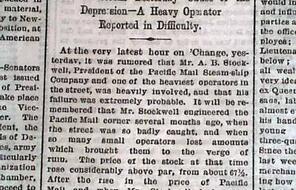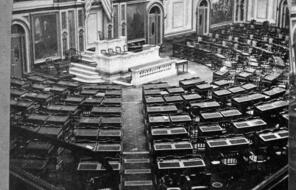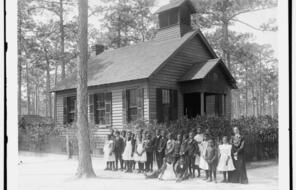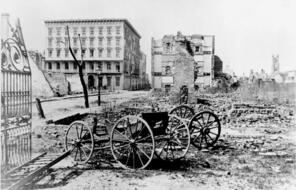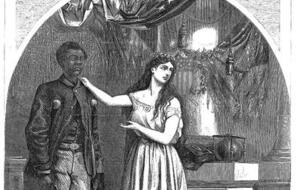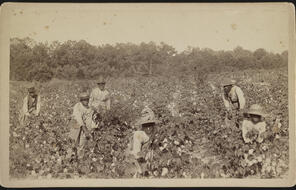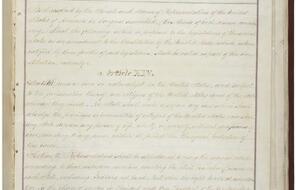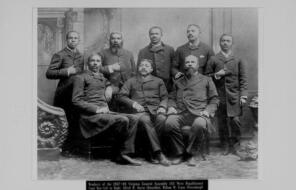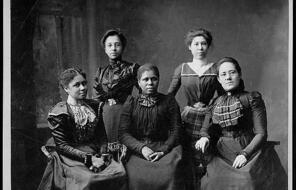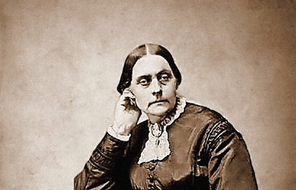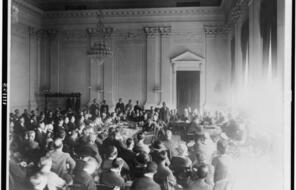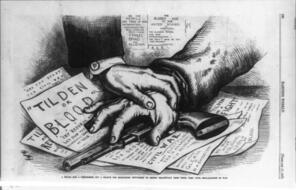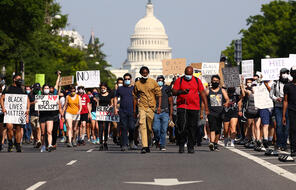By 1870, with the passage of the Fifteenth Amendment and the readmission of the last Confederate states into the Union, many Americans were already proclaiming that Reconstruction was complete. Upon the passage of the Fifteenth Amendment, Frederick Douglass himself declared, “We can now breathe a new atmosphere; we have a new earth beneath and a new sky above.” In 1872, as the federal government intervened to protect freedpeople from the Ku Klux Klan, Radical Republican Charles Sumner proclaimed:
Reconstruction is now complete. Every State is represented in the Senate, and every District is represented in the House of Representatives. Every Senator and every Representative is in his place. There are no vacant seats in either Chamber; and among the members are fellow-citizens of the African race.
The Radical Republican vision of freedom and political equality seemed to be coming to fruition. Yet, according to historian David Blight, the reality that Douglass and Sumner celebrated would soon prove to be only a dream.
In the 1870s, Northern public opinion shifted rapidly against Reconstruction in the South, enabling Southern white Democrats to perpetrate a new wave of violence without federal interference. According to Blight, the Radical Republican vision of American society would “crumble faster than it ever came into existence.”
This lesson will help students understand the reasons for the shift in Northern public opinion, and it will prompt them to consider what it takes to sustain progress toward freedom and equality in a democracy.
The shift in Northern sentiment was the result of myriad interdependent characteristics of the political, economic, and social life of the United States in the 1870s, but historians often point to the following as primary factors that led to the shift: (1) the dissipation of “war fever” following the Civil War, (2) the explosion of corruption in politics, (3) the Panic of 1873 and the economic depression that followed, and (4) the racism of white Northerners and Southerners and their tenuous opposition to the inclusion of African Americans in the identity of the nation.
Dissipation of War Fever
The Radical Republican coalition responsible for the laws and the amendments that sought to reshape Southern society was driven in part by passions and animosities that were left over from the Civil War. Andrew Johnson’s goal to restore “the Union as it was” prompted many moderate Republicans to side with the more radical members of their party in the effort to remake the South and reaffirm the Northern victory. In time, those wartime passions diminished, and as Reconstruction policies were proving successful at establishing freedom and some measure of equality for freedpeople in the South, moderate Republicans turned to other priorities. Many of the leaders of the Radical Republican movement themselves shifted to other political priorities (such as ending corruption), while others died or left Congress. Historian Michael Fitzgerald writes:
To some extent the popularity of Radical Republicanism had grown out of wartime patriotism. With the lapse of time, anger at white Southerners was likely to recede. New issues were moving to the fore, issues involving public and corporate malfeasance rather than slavery and its evils.
Corruption
The 1870s marked the beginning of the Gilded Age in the United States, a period characterized by both the massive creation of wealth and an explosion of corruption and patronage carried out by Republicans and Democrats alike at all levels of government and in all regions of the country. The Grant administration was beset by a series of corruption and patronage scandals that shook many Americans’ faith in the federal government. As David Blight explains, “Financial corruption became rampant in the Grant years, and . . . [this was] a huge political distraction away from the issues of the South, the issues of the freedmen, the issues of Reconstruction.”
Corruption existed outside of the Grant administration, from the Tammany Hall political machine run by Democrat Boss Tweed in New York City to some of the Republican state governments in the South. Opponents of Reconstruction seized on the public outrage over corruption and accused Northern “carpetbaggers” and African Americans of tyranny and misrule over white Southern Democrats. While corruption did exist in these Southern governments, as it did everywhere, many of the accusations directed at Southern states were unfounded and intended to stoke racist fears of “Negro rule” over white Americans. Fitzgerald explains:
Whatever went wrong, black voters were likely to get blamed, given all the racial stereotypes in play. African-American leaders were not the main actors, or the major beneficiaries in corruption, but then they didn’t need to be. Even behaving like their Gilded Age peers would do immense harm.
The Panic of 1873
In the spring of 1873, the US economy collapsed, ushering in a depression that would last several years. Blight explains:
A major economic depression had hit the country . . . that led to a great deal of labor strife and violence. It meant . . . that the issues now that politicians were most concerned about, and that voters were most concerned about, particularly in the North, were things like currency, tariffs, unemployment, railroad subsidies, labor strife, whether a union had the right to strike here or the right to strike there. And across the great Midwest, among farmers, the biggest issue was the price of wheat, which dropped from two dollars a barrel to fifty cents in a year and a half. Wages for manufacturing laborers in the United States, in a year and a half, dropped by fifty percent across the country; that’s for those who kept their jobs. The Panic of 1873 shifted people’s minds, to say the least.
Several Southern states, most notably South Carolina, fell into enormous debt as their economies collapsed, and again racists attempted to shift the blame onto African American politicians and voters. This time the charge was incompetence instead of corruption. In South Carolina, there is evidence that Republican politicians did in fact mismanage the state’s finances, but it was not the fault of African Americans. Fitzgerald explains: “Irresponsible behavior by Republican officials, much of it clandestine and virtually all by whites, imperiled the reputation of their African-American constituency.”
Racism
The shift in Northern public opinion was partially the result of the feeling that the war was in the past and Reconstruction was complete, and it was partially the result of Americans paying greater attention to corruption and economic concerns. Yet Northerners and Southerners alike also accepted racist caricatures of the corrupt, incompetent misrule by a supposedly inferior Black race in the South. Several Northern reporters, some of whom were even Radical Republicans, traveled south in the 1870s, embraced the claims of white Southern Democrats, and then passed them along in their reports to the North. The most notable example is the series of reports by James Pike in the New York Tribune, eventually collected in the popular 1874 book on South Carolina entitled The Prostrate State. Pike reported: “The civilized and educated white race was under foot, prostrate, and powerless, and the black barbarian reigned in its stead.”
Such accounts cemented the opposition of many Americans to land redistribution or other reparations to compensate for the labor provided to the United States by generations of the families of freedpeople. Now, in the views of many Americans by 1874, Reconstruction had gone too far, African Americans as a group had become too powerful, and the protection of freedpeople was no longer worth the cost of federal intervention.
Events in Louisiana between 1872 and 1874 would test the patience of a Northern public turning away from Reconstruction. While Republicans won the 1872 elections for governor and the majority of seats in the legislature, Democrats also declared victory and attempted to form their own government. The attempted coup touched off a vigilante war between Democrats and Republicans across the state that repeatedly required Grant to use the federal army to keep the peace. In 1874, Democrats attempted yet another coup by forcibly installing members of their party in five vacant seats in the Louisiana legislature. The army intervened, this time by entering the state capitol building and escorting the five Democrats out. Public opinion in the North aligned solidly against this intervention, and the idea of the military entering the capitol building of a state symbolized for many a too-powerful, untrustworthy federal government violating state sovereignty and putting too much effort into buttressing Reconstruction when it should be focused on other priorities. Historian Eric Foner writes: “Louisiana now came to represent the dangers posed by excessive federal interference in local affairs. The spectacle of soldiers ‘marching into the Hall . . . and expelling members at the point of bayonet’ aroused more Northern opposition than any previous federal action in the South.”
The Northern public no longer had the patience to sustain Reconstruction and defend the rights of freedpeople in the South.
